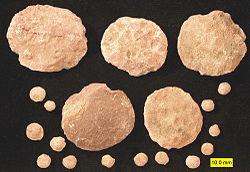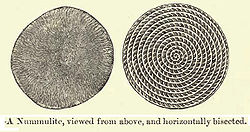Nummulite
Lua error in package.lua at line 80: module 'strict' not found.
| colspan=2 style="text-align: center; background-color: transparent; text-align:center; border: 1px solid red;" | Nummulites Temporal range: Tertiary
|
|
|---|---|
| colspan=2 style="min-width:15em; text-align: center; background-color: transparent; text-align:center; border: 1px solid red;" | Scientific classification | |
| Domain: | |
| Kingdom: | |
| Superphylum: | |
| Phylum: | |
| Order: | |
| Superfamily: | |
| Family: | |
| Genus: |
Nummulites
Lamarck, 1801
|
| colspan=2 style="text-align: center; background-color: transparent; text-align:center; border: 1px solid red;" | Species | |
|
Numerous |
|
Lua error in Module:Taxonbar/candidate at line 22: attempt to index field 'wikibase' (a nil value).

A nummulite is a large lenticular fossil, characterized by its numerous coils, subdivided by septa into chambers. They are the shells of the fossil and present-day marine protozoan Nummulites, a type of foraminiferan. Nummulites commonly vary in diameter from 1.3 cm (0.5 inches) to 5 cm (2 inches)[1] and are common in Eocene to Miocene marine rocks, particularly around southwest Asia and the Mediterranean (e.g. Eocene limestones from Egypt). Fossils up to 6 inches wide are found in the Middle Eocene rocks of Turkey.2 They are valuable as index fossils.
The ancient Egyptians used nummulite shells as coins and the pyramids were constructed using limestone that contained nummulites.[2] It is not surprising then that the name "Nummulites" is a diminutive form of the Latin nummulus meaning "little coin", a reference to their shape.
In 1913, naturalist Randolph Kirkpatrick published a book, The Nummulosphere: an account of the Organic Origin of so-called Igneous Rocks and Abyssal Red Clays, proposing the unconventional theory that all rocks had been produced through the accumulation of forams such as Nummulites.
References
- 'Nummulite', Tiscali Dictionary of Animals [1], retrieved 17 August 2004
- 2. 'Biggest Microbes', Guinness World Records 2001, p. 153.
- http://paleopolis.rediris.es/cg/CG2006_M02/index.html
Further Reading
Lua error in package.lua at line 80: module 'strict' not found.
Lua error in package.lua at line 80: module 'strict' not found.
Lua error in package.lua at line 80: module 'strict' not found.
Lua error in package.lua at line 80: module 'strict' not found.
Lua error in package.lua at line 80: module 'strict' not found.
Lua error in package.lua at line 80: module 'strict' not found.

